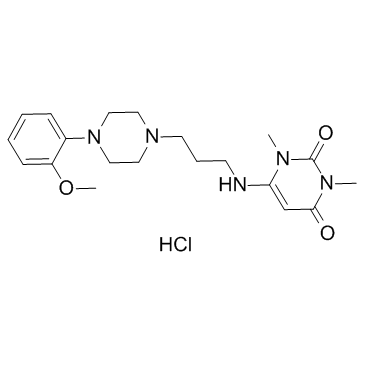Effects of α1-adrenoceptor antagonists on phenylephrine-induced salivary secretion and intraurethral pressure elevation in anesthetized rats.
Hiroko Yanai-Inamura, Akiyoshi Ohtake, Yukiko Noguchi, Toshiki Hatanaka, Masanori Suzuki, Koji Ueshima, Shuichi Sato, Masao Sasamata
Index: Eur. J. Pharmacol. 679(1-3) , 127-31, (2012)
Full Text: HTML
Abstract
α(1)-Adrenoceptor antagonists are widely used for the treatment of voiding dysfunction associated with benign prostatic hyperplasia. Activation of α(1)-adrenoceptors is reported to induce salivary secretion in rats and humans. However, the effects of α(1)-adrenoceptor antagonists on salivary secretion remain unknown. Here, we investigated the effects of the α(1)-adrenoceptor antagonists prazosin, silodosin, tamsulosin and urapidil on phenylephrine-induced salivary secretion and compared the results with the effects on phenylephrine-induced intraurethral pressure (IUP) elevation in anesthetized rats. All antagonists inhibited phenylephrine-induced salivary secretion and IUP elevation in a dose-dependent fashion. Comparison of DR(10) values (the dose required to shift the dose-response curve 10-fold to the right) in both tissues showed that the inhibitory effect of silodosin was significantly more potent in the salivary gland than in the urethra (18-fold), but tamsulosin (2.3-fold), prazosin (1.7-fold) and urapidil (1.1-fold) did not show comparable tissue selectivity. These results suggest that α(1)-adrenoceptor antagonists inhibit not only urethral contraction but also salivary secretion, and that high tissue selectivity for the salivary gland over the urethra as shown by silodosin may contribute to the incidence of dry mouth.Copyright © 2012 Elsevier B.V. All rights reserved.
Related Compounds
| Structure | Name/CAS No. | Molecular Formula | Articles |
|---|---|---|---|
 |
Urapidil Hydrochloride
CAS:64887-14-5 |
C20H30ClN5O3 |
|
Facilitation of expulsion of ureteral stones by addition of ...
2010-12-01 [Scand. J. Urol. Nephrol. 44(6) , 420-4, (2010)] |
|
Capillary electrophoresis with end-column electrochemilumine...
2015-12-01 [J. Chromatogr. B. Analyt. Technol. Biomed. Life Sci. 1006 , 146-50, (2015)] |
|
[Hypertensive crisis in cardiology: place of urapidil].
2012-01-01 [Kardiologiia 52(1) , 86-90, (2012)] |
|
Urapidil, a dual-acting antihypertensive agent: Current usag...
2010-07-01 [Adv. Ther. 27(7) , 426-43, (2010)] |
|
Synthesis of a quinazoline derivative: a new α₁-adrenoceptor...
2011-10-01 [Bioorg. Med. Chem. Lett. 21(19) , 5905-9, (2011)] |